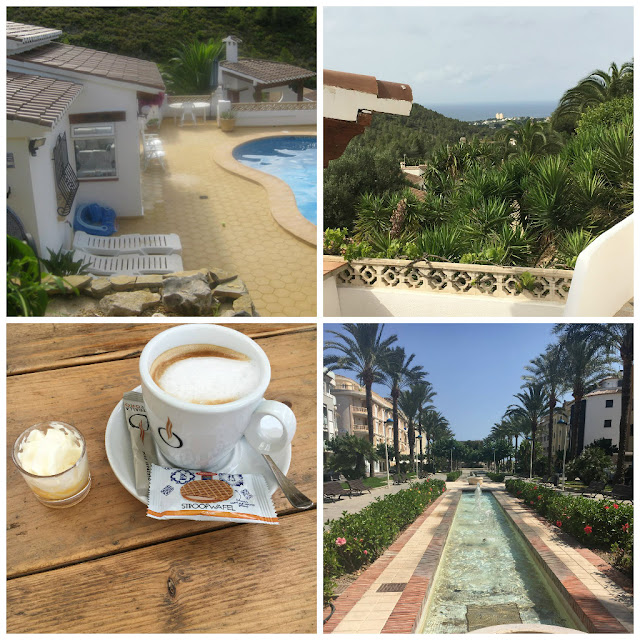This past week since I came back from holiday has been long and looking at these photos has me itching to jump on the next plane to Alicante and go back to the warm and chilled shores of Moraira.
Moraira is a marina town on the Costa Blanca, about 45 minutes away from Alicante. Despite its closeness to the fairly built-up tourist spots of Benidorm and Calpe, it's incredibly unspoilt and a really peaceful place to spend a week away from the turmoil that was the week of Brexit in the UK. It's a place my family and I have visited fairly regularly since I was about 8, so it feels like a really true home away from home for us.
Our 'home from home', the villa we stayed in; the view down to El Portet; coffee at El Cafeti de la Mar; fountains in Moraira
What We Did
When we weren't just chilling out by the pool, we headed to...
El Portet Beach: My personal favourite. Not as big as Moraira, but the sea is almost still. You have to walk for ages before it gets deep enough to swim in, and you can spot fish and all sorts in the sea too. It's served by two cafes, the one further down is the better one if you fancy a quick toastie or sandwich and drink whilst you're there (they've also got a lovely cat).
Altea: On a day that was supposed to be overcast and then turned out to be pretty scorchio, we visited the nearby town of Altea. It has a really beautiful old church at the centre of its raised old town and a really nice seafront packed with bars and restaurants. It's also got great shopping and markets (where you can get 10 churros for about 2euros).
The view down to El Portet beach; the view across to Calpe from El Portet; Moriara beach; that lemon drink <3
Where We Ate/Drank
Del Pescador, Calle Mar 33: This place has bizarrely sniffy reviews on TripAdvisor which I find totally confusing. We liked it here so much we went twice (and we've been loads before). A really traditional Spanish restaurant, we first had the Menu of the Day (which was amazing value) and second time around we had a paella. The service has never not been great when we've been; a lot of the reviews seem to suggest that the staff don't understand English which is just plain wrong (though it obviously helps if you can at least speak a touch of Spanish) I really recommend it for actual authentic food.
Pulcinella, Avda de la Paz 14: It feels a bit weird to be including an Italian restaurant on a list of restaurants in Spain but this is so. good. Amazingly fresh pasta, pizzas that look great and some amazing anti-pasti (the beef tartare with tuna is incredible). Plus their deserts are great, as is the service.
Vista Ifach, Castillo 11: This is a long-time family favourite. A traditionally Spanish restuarant (though it's diversifying into pizza & pasta now) with really great sea-food. Plus it has the best pan y aioli anywhere.
Gelateria Venezia, Calle de Mar: Another place we've been going forever. Amazingly tasty and good value ice-cream in a million different flavours or sundaes. The coffee is good if you are wrong and don't enjoy ice-cream.
Xambel Bar, Calle Castillo 16: This is a great place for a pre-dinner drink where you can watch the world go by. They also do great tapas if you fancy that.
El Cafeti de la Mar, Calle Castillo 30: We popped into this cafe for a breakfast treat on our first day. You can't go wrong with a toasted croissant or sandwich AND the coffee here comes complete with a shot of Advocaat and cream. At 11am. Wonderful.
Fishy Fishy, Kristalmar 30F: I do feel a tiny bit bad for including a Fish & Chips restaurant, but this was pretty much better than a lot of chippies back home. I had a Thai-style fishcake which was delicious and super fresh too. The portions are quite generous as a warning.
Altea church; me on our last night rocking some freckles; Vista Ifach dinner; Geleteria Venetia ice-cream
If someone could throw me a couple hundred Euros so I can head back I would be there again in a heartbeat.
Extra Notes
We flew from East Midlands Airport to Alicante, with Ryanair and returned with Jet2. Most British airports fly into Alicante which is about a 45 minute drive. Valencia is another option but a tad further away.
We hired a care from Goldcar (Moraira isn't brilliantly served by public transport), which was great aside from the two back passenger seats mysteriously missing seatbelts (?)
Our villa is owned by a couple who are selling up this year (sobsobsob), you can find plenty in the area and there are a couple of hotels in Moraira town itself too.








